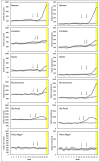Tracking excess deaths associated with the COVID-19 epidemic as an epidemiological surveillance strategy-preliminary results of the evaluation of six Brazilian capitals
- PMID: 33174964
- PMCID: PMC7670756
- DOI: 10.1590/0037-8682-0558-2020
Tracking excess deaths associated with the COVID-19 epidemic as an epidemiological surveillance strategy-preliminary results of the evaluation of six Brazilian capitals
Abstract
Introduction: In March 2020, the World Health Organization declared the coronavirus disease (COVID-19) outbreak a pandemic. In Brazil, 110 thousand cases and 5,901 deaths were confirmed by the end of April 2020. The scarcity of laboratory resources, the overload on the service network, and the broad clinical spectrum of the disease make it difficult to document all the deaths due to COVID-19. The aim of this study was to assess the mortality rate in Brazilian capitals with a high incidence of COVID-19.
Methods: We assessed the weekly mortality between epidemiological week 1 and 16 in 2020 and the corresponding period in 2019. We estimated the expected mortality at 95% confidence interval by projecting the mortality in 2019 to the population in 2020, using data from the National Association of Civil Registrars (ARPEN-Brasil).
Results: In the five capitals with the highest incidence of COVID-19, we identified excess deaths during the pandemic. The age group above 60 years was severely affected, while 31% of the excess deaths occurred in the age group of 20-59 years. There was a strong correlation (r = 0.94) between excess deaths and the number of deaths confirmed by epidemiological monitoring. The epidemiological surveillance captured only 52% of all mortality associated with the COVID-19 pandemic in the cities examined.
Conclusions: Considering the simplicity of the method and its low cost, we believe that the assessment of excess mortality associated with the COVID-19 pandemic should be used as a complementary tool for regular epidemiological surveillance.
Conflict of interest statement
Figures



Similar articles
-
Preliminary Estimate of Excess Mortality During the COVID-19 Outbreak - New York City, March 11-May 2, 2020.MMWR Morb Mortal Wkly Rep. 2020 May 15;69(19):603-605. doi: 10.15585/mmwr.mm6919e5. MMWR Morb Mortal Wkly Rep. 2020. PMID: 32407306
-
Rapid Estimation of Excess Mortality during the COVID-19 Pandemic in Portugal -Beyond Reported Deaths.J Epidemiol Glob Health. 2020 Sep;10(3):209-213. doi: 10.2991/jegh.k.200628.001. J Epidemiol Glob Health. 2020. PMID: 32954711 Free PMC article.
-
Excess Out-of-Hospital Mortality and Declining Oxygen Saturation: The Sentinel Role of Emergency Medical Services Data in the COVID-19 Crisis in Tijuana, Mexico.Ann Emerg Med. 2020 Oct;76(4):413-426. doi: 10.1016/j.annemergmed.2020.07.035. Epub 2020 Jul 23. Ann Emerg Med. 2020. PMID: 33012377 Free PMC article.
-
COVID-19 pandemic and total mortality in the first six months of 2020 in Italy.Med Lav. 2020 Oct 31;111(5):351-353. doi: 10.23749/mdl.v111i5.10786. Med Lav. 2020. PMID: 33124605 Free PMC article.
-
Excess all-cause mortality during the first wave of the COVID-19 epidemic in France, March to May 2020.Euro Surveill. 2020 Aug;25(34):2001485. doi: 10.2807/1560-7917.ES.2020.25.34.2001485. Euro Surveill. 2020. PMID: 32856584 Free PMC article.
Cited by
-
Assessing COVID-19 pandemic excess deaths in Brazil: Years 2020 and 2021.PLoS One. 2023 May 25;18(5):e0272752. doi: 10.1371/journal.pone.0272752. eCollection 2023. PLoS One. 2023. PMID: 37228083 Free PMC article.
-
Disparities in Excess Mortality Between Indigenous and Non-Indigenous Brazilians in 2020: Measuring the Effects of the COVID-19 Pandemic.J Racial Ethn Health Disparities. 2022 Dec;9(6):2227-2236. doi: 10.1007/s40615-021-01162-w. Epub 2021 Sep 28. J Racial Ethn Health Disparities. 2022. PMID: 34581998 Free PMC article.
-
How many more? Under-reporting of the COVID-19 deaths in Brazil in 2020.Trop Med Int Health. 2021 Sep;26(9):1019-1028. doi: 10.1111/tmi.13628. Epub 2021 Jun 6. Trop Med Int Health. 2021. PMID: 34008266 Free PMC article.
-
Estimation of all-cause excess mortality by age-specific mortality patterns for countries with incomplete vital statistics: a population-based study of the case of Peru during the first wave of the COVID-19 pandemic.Lancet Reg Health Am. 2021 Oct;2:None. doi: 10.1016/j.lana.2021.100039. Lancet Reg Health Am. 2021. PMID: 34693394 Free PMC article.
-
[Impact of COVID-19 on home mortality in the city of Rio de Janeiro, Brazil: temporal and spatial analysis, 2010 to 2020].Cad Saude Publica. 2025 May 23;41(5):e00017524. doi: 10.1590/0102-311XPT017524. eCollection 2025. Cad Saude Publica. 2025. PMID: 40435022 Free PMC article. Portuguese.
References
-
- World Health Organization Coronavirus disease (COVID-19) outbreak. 2020. [2020 Mar 3]. Available from: https://www.who.int/emergencies/diseases/novel-coronavirus-2019.
-
- Brazil. Health Surveillance Secretariat - Ministry of Health of Brazil . Coronavirus - COVID-19. Ministry of Health; [2020 May 8]. Available from: https://coronavirus.saude.gov.br/
-
- Brazil. Health Surveillance Secretariat - Ministry of Health of Brazil . Coronavirus Disease 2019 - Special Epidemiological Laboratory Surveillance. Brasília: [2020 May 8]. Available from: https://covid.saude.gov.br/
-
- Hallal P, Horta B, Barros A, Dellagostin O, Hartwig F, Pellanda L, et al. Trends in the prevalence of COVID-19 infection in Rio Grande do Sul, Brazil: repeated serological surveys. 2020. [2020 May 8]. Available from: https://preprints.scielo.org/index.php/scielo/preprint/view/41. - PubMed
MeSH terms
LinkOut - more resources
Full Text Sources
Miscellaneous

